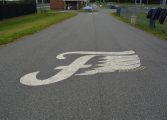Dredging
A persistent issue in the Lake Monticello community is land runoff.
It fills up the lake with silt, leaves and other debris.
The lake’s many inlets and narrow, shallow coves tend to fill up fastest.
The LMOA Board developed a multi-year dredging plan to deal with the matter. The LMOA bought a floating excavator, also called a track-hoe, and a barge.
They also paid a contractor to build a concrete bulkhead at Jackson Cove near Beach 4 to offload the debris onto a truck. Debris is trucked to a fenced off spot near Tufton Lake.
In 2009, the first year of the project, the operator dredged up more than 3,000 cubic yards from four major coves. Dredging continued every year, according to LMOA reports, freeing the lake bottom of almost 31,000 cubic yards of silt and debris.
Why build an additional bulkhead?
LMOA Board President Rich Barringer addressed 15 of the group’s concerns in an open letter in the July 14 issue of the Lake Monticello newspaper, Lake Views.
On why the proposed $85,000 bulkhead is necessary, Barringer wrote, “We need better access to the eastern and western ends of the lake… Having bulkheads at the ends of the lake expands our ability to dredge the areas in colder weather.”
Better access to the eastern and western ends of the lake means the truck full of debris will have to drive three more miles of heavily traveled, hilly, twisting Jefferson Drive to get to the Tufton Lake dumping site, Ellis said.
“Looking at it from an engineering point of view, there’s no reason for it,” he said. “And even if it’s a complete trade-off, why do it?”
Barringer’s answers include, “We have not had an incident with the truck,” and “The truck is no larger than vehicles that provide goods and services to our homes.”
One of the residents against it is Linda Sawyer. She readily admits her property overlooks Beach 2 and she doesn’t want it in her backyard. But that’s not the only reason, she said.
“It is one of the best beaches to take children,” Sawyer said. “It’s flat and clean. There are trees all around.”
She is concerned about the barge negotiating around bathers to reach the planned offload bulkhead at Beach 2.
Barringer answered that concern in his printed address, writing, “Full or empty, [the barge] has operated safely for seven years in all quarters of the Lake. The route and number of trips a day traveled by the barge is the same for the current dredging at Beach 2 as it would be to use the site for offloading. We have had no safety incidents with the dredge or barge.”
Ellis said if an offloading bulkhead is built at Beach 2, the barge will travel through the bathing area past the beach more than 40 times a week – far more than it did while just dredging the cove. And the barge does not have to pass the bathing area at Beach 4 because the bulkhead to which it docks when offloading is at least a football field-length away from the swimming area. It is also separated from swimmers’ view by a stand of trees.
The one proposed at Beach 2 would be visible to swimmers.
Postpone the vote
What everyone who has spoken against the bulkhead wants is for the LMOA Board to postpone making a final decision until a study is done.
So far, Board member Stephanie Davis is the lone voice against the project. Davis said she will propose at the Aug. 25 meeting that the vote be deferred.
She said there has been no study of the dredging program since its inception in 2009. She questions adding another bulkhead when there is no identifiable need for it.
“No Board of Directors since 2009 when Beach 2 was removed from consideration as a second offloading site has addressed this ‘need,’” Davis wrote in an email. “Times and wants/needs have changed in the last seven years. We have projects in need of funds. We have a fiduciary duty to the Association not to spend money simply because we can. There is no identifiable need for such permanent damage to the asset that is Beach 2.”
Barringer agreed the project would be voted on at the next Board meeting. “If passed, construction will take place this fall,” he wrote in an email. “The long-term dredging program was approved with three offload sites on the main lake and one on Tufton Pond. The Board in 2009 approved the first two sites at Beach 2 and Beach 4. Both had engineering drawings drafted; however, due to monetary reasons, at that time, the Board did not construct the bulkhead at Beach 2.”




